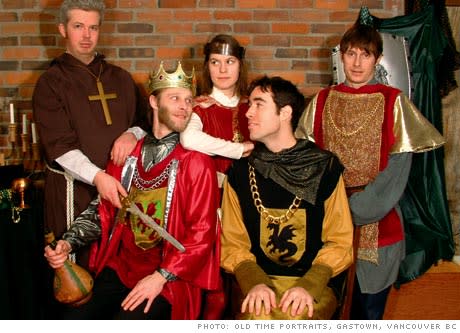Since the release of their 2003 album, Love This Time, the Buttless Chaps have exposed their assets to the U.S. and the UK, and brought new member Ida Nilsen into the fold. After nearly ten years of drawing upon collective influences to create what is often described as an odd but entertaining blend of new wave and country, the Chaps continue to forge their own sound. While genre-specific descriptions have been justifiable in the past, the band have become increasingly harder to pin down. Love This Time vacillated delightfully between the synthesiser and the banjo, but on Where Night Holds Light, their latest release, these sounds have coalesced and the disparate themes have come together to redefine the band.
As singer Dave Gowans puts it: "We have our own sound now; I feel like it's the first cohesive Buttless Chaps album." The band took its time putting this new collection of songs together, but Gowans believes the album is more fluid as a result. "We had more songs to choose from and we weren't as rushed."
The group do seem more at ease. Gowans' baritone voice is bolder and the music sounds more assured. The emotion and imagery of their previous efforts is still there, but the synth-heavy lonesome cowboy blues come together to conjure an almost post-apocalyptic landscape.
"I'm interested in industrial imagery but also rural imagery," Gowans says. The contrast isn't a surprise, considering the band divide time between rural Northern BC and the urban sprawl that crowds the 49th parallel. "There's a lot of time spent going back and forth and you're constantly having to adjust," he explains. Somewhere between growing up in the anxious '80s and finding solace under an unpolluted night sky, the Buttless Chaps have found a light they can gather around.
As singer Dave Gowans puts it: "We have our own sound now; I feel like it's the first cohesive Buttless Chaps album." The band took its time putting this new collection of songs together, but Gowans believes the album is more fluid as a result. "We had more songs to choose from and we weren't as rushed."
The group do seem more at ease. Gowans' baritone voice is bolder and the music sounds more assured. The emotion and imagery of their previous efforts is still there, but the synth-heavy lonesome cowboy blues come together to conjure an almost post-apocalyptic landscape.
"I'm interested in industrial imagery but also rural imagery," Gowans says. The contrast isn't a surprise, considering the band divide time between rural Northern BC and the urban sprawl that crowds the 49th parallel. "There's a lot of time spent going back and forth and you're constantly having to adjust," he explains. Somewhere between growing up in the anxious '80s and finding solace under an unpolluted night sky, the Buttless Chaps have found a light they can gather around.
